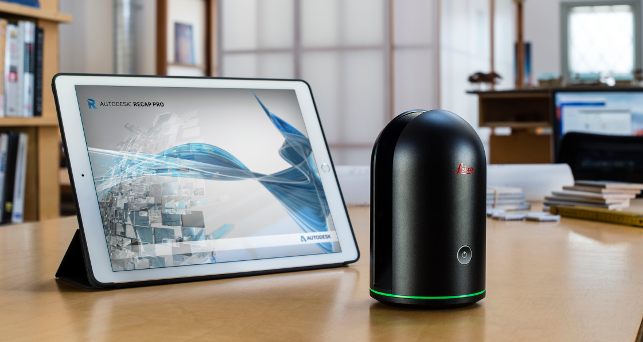
While the scanner alone will store over 100 reality captures, the BLK360 acts as its own wi-fi router, sending scans direct to partnered devices (iPad Pro at present, with Android to come soon)
Small, lightweight, black anodised aluminium, and with just a single button, the Leica Geosystems BLK360 is barely recognisable as a professional grade 3D scanner.
That button, however, unleashes its inner purpose – once pressed, three minutes later you have a full 3D scan of the room, in a combined laser, photogrammetry and even heat-mapped model that is ready to be used instantly in architectural software Autodesk ReCap Pro on a partnered iPad.
Its design is set to shake up the architectural reality capture market; its compact form and high-end finish directly targets architects wanting to pop it in their bags to take to smaller jobs, and its one-button functionality means anyone can operate it without a need for traditional surveying services.
For Leica Geosystems, the design process of the BLK360 was equally as disruptive, creating a special group internally at its Heerbrugg headquarters in Switzerland, focussed singularly on the product.
With experts from each element of the design, software, firmware, engineering, manufacturing and procurement process collaborating as one, this represented a change from its traditional ‘waterfall’ design process. “It was like a software start-up,” says Hexagon Geosystems CTO Burkhard Boeckem.
“Every morning the team sat down for 15 minutes and went around: ‘Who did what yesterday?’, and ‘What needs doing today?’. For anything we could do we had five options. We changed it rapidly.”

Design proposals on whiteboard
Design language
The design evolved from competition design (brief: ‘It should not look like a scanner, but a timeless luxury item’) coupled with its own design heritage, such as the domed case of one of its earliest models, the Leica T2 theodolite.
Boeckem states that while the single button functionality was a key element, its aesthetics needed to be equally appealing, going as far to use the term ‘insanely beautiful’ in the brief.
After concept sketches, a 3D CAD model was produced in Siemens NX while the design was constantly updated on an almost daily basis as new ideas took shape.
Quick renderings continually reimagined the new iterations and lined walls of the design space, while physical shape models were 3D printed and painted up to help get a sense of the product as it evolved.
The scanner’s internals were kitted out via a ‘technology shopping trip’ through the vast innovation stores of its parent company Hexagon, before miniaturising the entire platform.
“The nice thing inside Hexagon on the Leica campus is the precision workshop,” says Boeckem. “We’d just kidnap machines!”

Design mockups
BLK360 – Product testing
Along with design changes, product testing accounted for a lot of casualties among the physical prototypes, with hardcore drop, sand and water tests needing to be completed.
Those producing the parts for prototypes would typically make a run of 500 parts at a time, yet for this project would only produce a couple of parts each day as there would most likely be design iterations the next day, and the day after, such was the quest for perfection.
From the pin-prick hole in the self-balancing mirror arm for noise cancellation, to the custom-built fold-flat tripod, Leica has gone about this project with a painstaking eye for detail, with each unit still hand assembled in Heerbrugg.
There are no cables needed for operation, and internally there are no wires, just flexible connectors linking PCB boards and sensors.
Its battery life is good for 40 scans – a single residential house takes around 12 on average – while inbuilt LED lighting and weather proofing to IP54 standards mean it can be used both indoors and out.
For Leica Geosystems, the BLK360 is by far the most beautiful of all its technologies, but it also marks itself out as one of the most accessible.
As Boeckem’s team summed up, it should be a device that you really want to take with you to work.

The 1kg unit is protected by a plexiglass cover, but otherwise its rotating base and optional tripod are the only travel companions it needs
For more on the performance of the Leica BLK360, read this preview in DEVELOP3D’s sister publication AEC Magazine






